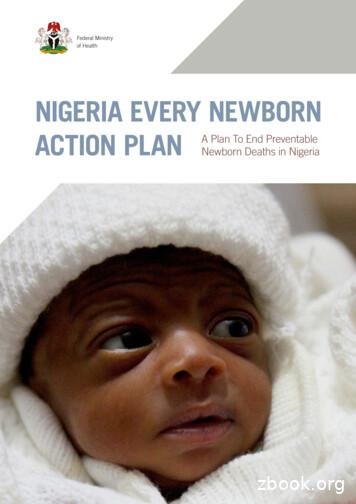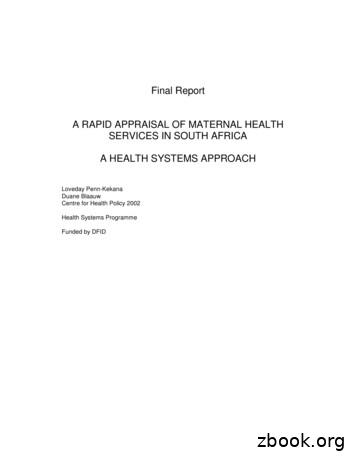Maternal And Newborn Health Disparities Myanmar
Maternal and Newborn Health Disparities UNICEF/UNI136051/DeanMyanmar
2Myanmar
Maternal and Newborn Health Disparities in MyanmarKey FactsMyanmar reference tableDemographic indicatorsTotal population (thousands)1201553,897Total live births (thousands)12015944Total Fertility Rate (number of children per woman)120152Adolescent birth rate (per 1,000 women 15-19)10200617Maternal mortality ratio (per 100,000 live births)42015178Average annual rate of MMR reduction between 1990 and 2015 (%)520153.7Lifetime risk of maternal death: 1 in x 42015260Stillbirth rate (per 1,000 total births)6201520Preterm birth rate (per 100 live births)7201012Under-five mortality rate (per 1,000 live births)3201550Under-five deaths that are newborn (%)3201553Neonatal mortality rate (per 1,000 live births)3201526Neonatal deaths (thousands)3201524––Impact indicatorsService DeliveryAvailability of EmONC Services (% of minimum acceptable level)8Physician density (per 1,000 population)920120.6Nurse and midwife density (per 1,000 population)920121.0In 2015, 940,000 babies were born inMyanmar, or around 2,600 every day.15 percent of adolescent girls (aged 15-19)have had a live birth.*Approximately 67 babies will die each daybefore reaching their first month3;51 stillbirths occur every day.6Neonatal mortality rate:Myanmar’s neonatal mortality rate (NMR) is 26 deaths per 1,000 live births.31in 20adolescent girls(aged 15-19)have had alive birth.*Myanmar3
Myanmar — Causes of Neonatal Mortality, 2015Injuries, 2.1%In Myanmar, the main causesof neonatal death in 2015were prematurity (35.6%),birth asphyxia andbirth trauma (24.9%),and sepsis (13.4%).11Acuterespiratoryinfections,5.6%Tetanus, .6%Sepsis13.4%Birth asphyxiaand birth trauma24.9%Diarrhoeal diseases, 0.6%Other NCDs, 0.1%Pertussis, 0.1%HIV/AIDS, 0.1%Disparities in key maternal and newborn health interventions, Myammar 2009-2010 and 2015-20162Coverage – care for mothersDemand forcontraceptionsatisfied bymodern methods(%)*Antenatal carecoverage at least4 times (%)*Skilled attendantat birth (%)*Institutionaldelivery (%)*Delivered bycaesareansection (%)Postnatal careof motherswithin 2 Poorest69.338.536.316.858.01.12.32.74.91.5Less than .338.773.8ResidenceResidence ratio (urban to rural)HouseholdWealthHousehold wealth ratio(richest to poorest)Mother’sageMother’seducationNo .372.2Secondary79.674.178.753.476.5Secondary or higherHigherMother’s education ratio(highest to lowest)4Myanmar1.390.694.882.689.22.93.46.51.9
Maternal and newborn health coverage indicatorsBy residence:2By household wealth:2 In rural areas, 51 percent of womenmade at least 4 antenatal care (ANC)visits compared to 84 percent inurban areas. Most mothers among richesthouseholds (89 percent) made atleast four ANC visits, comparedto 39 percent of mothers fromthe poorest households. Coverage of skilled attendance at birthis 52 percent in rural areas, comparedto 88 percent in urban areas. 86 percent of newborns in rural areasreceived the BCG vaccine, comparedto 92 percent in urban areas.39%Onlyof mothers in the pooresthouseholds have 4 AntenatalCare visits compared to.39% Only 36 percent of deliveriesin the poorest householdshad a skilled attendant atbirth, compared to 97 percentof deliveries among therichest households.89%PoorestRichest.89% of mothers in therichest households. 98 percent of newborns in therichest households receivedthe BCG vaccine, compared to86 percent among the pooresthouseholds.Coverage – care for newbornsPostnatalcare ofnewbornswithin 2days (%)Newbornweighed atbirth (%)**OtherEarly initiation ofbreastfeeding (%)**Exclusivebreastfeeding ( 6months)(%)**BCG vaccinefor newborn(%)*TetanusPentavalent protectionBirth1 vaccination for newborns registrationreceived (%)* (%)*(%)**Women aged15-19 whohave had alive .50.7Residence ratio(urban to 1.90.2Household wealth ratio(richest to poorest)ResidenceHouseholdWealthLessthan rimary91.090.180.72.5Secondary72.52.4Key for tables:80.524.21.21.20-24 %Secondaryor Higher85.396.096.084.11.31.41.525-49 %50-74 �s education ratio(highest to lowest)Data notavailableMyanmar5
Selected maternal and newborn health indicators,by region, 2015-2016By mother’s age:* 61 percent of mothersaged 20-34 made at leastfour ANC visits, compared to46 percent among youngermothers (aged less than 20).100908070646258Percent 37979796767635854508784806865605657 61 percent of deliveries amongmothers aged 20-34 had a skilledattendant at birth, compared to57 percent of deliveries amongyounger mothers (aged less than 20).4030302120 71 percent of mothers aged 20-34had a postnatal checkup within2 days after birth, compared to67 percent among younger mothers(aged less than 20).10Skilled attendantat birthPostnatal care ofnewborns within 2 0Antenatal care coverageat least 4 timesDisparities in key maternal and newborn health interventions, Myammar 2009-2010 and 2015-20162Coverage – care for mothersDemand forcontraceptionsatisfied bymodern methods(%)*Antenatal carecoverage at least4 times (%)*Skilled attendantat birth (%)*Institutionaldelivery (%)*Delivered bycaesareansection (%)Postnatal careof motherswithin 2 days(%)*National .078.746.879.1Mon71.763.466.837.075.2Bago (East)RegionBago .250.034.070.8Nay Pyi Taw77.856.166.535.883.9Shan (North)Shan (East)Shan (South)6Myanmar
By mother’s education:*By geographic regions:*The better educated the mother is, themore likely she will receive critical 48 percent of mothers had apostnatal checkup within 2 daysafter birth, compared to 72 percentof mothers with a primary educationand 89. percent of mothers with ahigher education.None Only 28 percent of deliveries amongmothers with no education had askilled attendant at birth, comparedto 56 percent of deliveries amongmothers with primary educationand 95 percent of deliveries amongmothers with a higher education.28%Highermaternal health servicesPrimary 91 percent of mothers with a highereducation made at least four ANCvisits, compared to only 31 percentof mothers with no education.56%95%Percentage of deliveries having a skilledbirth attendant relative to the mother’slevel of education Yangon saw the highest rate ofantenatal care coverage (at least fourvisits) of 85 percent, compared tothe lowest coverage of 40 percentin Chin. The region with the highestcoverage of skilled birth attendanceis Yangon with 83 percent; thelowest coverage is Rakhine with 30percent – a difference of 2.8 times. Magway had 92 percent of mothersreceiving a postnatal checkup within2 days of birth, compared to thelowest coverage of 21 percentin Chin.Coverage – care for newbornsPostnatalcare ofnewbornswithin 2days (%)Newbornweighed atbirth (%)**OtherEarlyinitiationof breastfeeding (%)**Exclusivebreast feeding( 6 months)(%)**BCG vaccinefor newborn(%)*Pentavalent1 vaccinationreceived(%)*TetanusprotectionBirthfor newborns registration(%)*(%)**Women aged15-19 whohave had alive birth(%)*56.375.823.687.886.971.972.45.0National 6.496.484.695.23.8Yangon76.174.757.94.8ShanBago (East)80.0Bago (West)Region36.472.512.952.3Shan (North)92.672.523.395.4Shan (East)73.889.327.879.2Shan (South)49.773.325.0Key for tables:0-24 %74.576.771.0(97.7)(91.0)72.225-49 %50-74 %69.875-100%4.0Ayeyarwaddy5.9Nay Pyi TawData notavailableMyanmar7
Sources:1 United Nations, Department of Economic and Social Affairs, Population Division (2015). World PopulationProspects: The 2015 Revision.2 Ministry of National Planning and Economic Development and Ministry of Health, Myanmar, 2011. MyanmarMultiple Indicator Cluster Survey 2009 - 2010 Final Report. Nay Pyi Taw, Myanmar. Ministry of NationalPlanning and Economic Development and Ministry of Health, Myanmar; Ministry of Health and Sports (MOHS)and ICF International. 2016. Myanmar Demographic and Health Survey 2015-16: Key Indicators Report. Nay PyiTaw, Myanmar, and Rockville, Maryland, USA: Ministry of Health and Sports and ICF International.3 United Nations Inter-agency Group for Child Mortality Estimation (UNICEF, WHO, United NationsPopulation Division and the World Bank).4 United Nations Maternal Mortality Estimation Inter-agency Group (WHO, UNICEF, UNFPA,United Nations Population Division and the World Bank).5 Trends in maternal mortality: 1990 to 2015: estimates by WHO, UNICEF, UNFPA, World Bank Groupand the United Nations Population Division.6 Lawn JE, Blencowe H, Waiswa P, et al, for The Lancet Ending Preventable Stillbirths Series study groupwith The Lancet Stillbirth Epidemiology investigator group. Stillbirths: rates, risk factors, and accelerationtowards 2030. Lancet 2016; published online Jan 18. http://dx.doi.org/10.1016/S0140- 6736(15)00837-5.7 Blencowe H, Cousens S, Oestergaard M, Chou D, Moller AB, Narwal R, Adler A, Garcia CV, Rohde S,Say L, Lawn JE. National, regional and worldwide estimates of preterm birth rates in the year 2010 withtime trends since 1990 for selected countries: a systematic analysis and implications. The Lancet,June 9 2012, 379(9832): 2162-72.8 Averting Maternal Death and Disability, United Nations Children’s Fund, and United NationsPopulation Fund special data compilation, 2015.9 Global Health Workforce Statistics database, World Health Organization, /).10 United Nations, Department of Economic and Social Affairs, Population Division (2015).2015 Update for the MDG Database.11. WHO-MCEE estimates for child causes of death, 2000-2015. (http://www.who.int/healthinfo/globalburden disease/estimates child cod 2015/)Notes:*Data from DHS 2015-2016 Key Indicators Report.** Data from MICS 2009-2010 Final Report. Reference period: five years preceding the survey.( ) Based on small denominators (typically 25-49 unweighted cases). No data based on fewer than25 unweighted cases are displayed.8Myanmar
Myanmar 3 Key Facts Maternal and Newborn Health Disparities in Myanmar In 2015, 940,000 babies were born in Myanmar, or around 2,600 every day.1 5 percent of adolescent girls (aged 15-19) have had a live birth.* Approximately 67 babies will die each day before reaching their first month3;
P007 Newborn affected by oth medical procedures on mother, NEC P0081 Newborn affected by periodontal disease in mother P0089 Newborn affected by oth maternal conditions P009 Newborn affected by unsp maternal condition P010 Newborn (suspected to be) affected by incompetent cervix P011 Newborn (suspected to be) affected by premature ROMFile Size: 1MB
Nursing 1 Maternal Newborn Nursing exam The above chart shows the percentage distribution of questions on the Maternal Newborn Nursing exam across the major content categories covered on the examination. The major focus of the examination is on the Maternal Postpartum Assessment, Management and Education, Maternal Postpartum Complications and .
1.1 Development of the Nigeria Every Newborn Action Plan 6 1.2 Overview of the Nigeria Every Newborn Action Plan 6 1.3 The Global Picture 7 2.0 The State of Nigeria's Newborns 8 2.1 Newborn Mortality Trends and Disparities 8 2.2 Causes of Neonatal Mortality 9 2.3 Stillbirths 10 2.4 The Maternal and Newborn Health Continuum of Care 10
Work on maternal health services has begun with a rapid appraisal of maternal health care in each of the participating countries. Maternal health services and the improvement of maternal mortality are internationally acknowledged as priority issues for health services development. Maternal health services are also useful as a health system probe.
Philippines 3 Philippines Maternal and Newborn Health Disparities In 2015, approximately 2,300,000 babies were born in Philippines, or around 6,400 every day.1 Among young women (aged 20-24), 8 percent gave birth by age 18.2 Approximately 81 babies will die each day before reaching their first month3; 71 stillbirths occur every day.6 Neonatal mortality rate:
Indonesia 3 Indonesia Maternal and Newborn Health Disparities In 2015, approximately 5,000,000 babies were born in Indonesia, or around 13,800 every day.1 Among young women (aged 20-24), approximately 7 percent gave birth by age 18.2 Approximately 203 babies will die each day before reaching their first month3; 201 stillbirths occur every day.6 Neonatal mortality rate:
ity and mortality and to eliminate disparities in health between segments of the U.S. population. The first of its kind, this 2011 CDC Health Disparities and Inequalities Report (2011 CHDIR) represents a milestone in CDC's long history of working to eliminate disparities (2-6). Health disparities are differences in health outcomes and their
community’s output this year, a snapshot of a dynamic group of scholars. The current contributors represent a wide sampling within that community, from first-year mas-ter’s to final-year doctoral students. Once again, Oxford’s graduate students have outdone themselves in their submis - sions. As was the case in the newsletter’s first






















